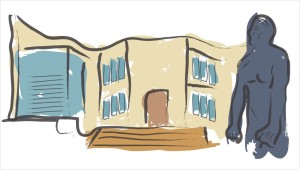The place where the Iris and B. Gerald Cantor Center for Visual Arts now stands was once home to the Leland Stanford Jr. Museum. The museum was founded in 1891, the same year as the University, and opened to the public in 1894. It originally housed the artifacts that Leland Stanford Jr., the University’s namesake, collected in Europe before his death at age 15 of typhoid fever.

The museum was hit by the 1906 earthquake and later closed in 1945 following years of disuse, but the next year a committee was established to rejuvenate the museum. Over time, the site branched out to incorporate holdings beyond Stanford’s initial collection. Eventually, the museum committee decided to look outside of Stanford’s campus to receive additional funds and direction.
The external contributors recruited to revamp the museum’s direction and financial backing were Iris and Gerald B. Cantor, prominent art collectors and philanthropists.
“Iris and B. ‘Bernie’ Gerald Cantor, a successful financier and philanthropist, became serious collectors of Rodin sculptures after Mr. Cantor saw Rodin’s ‘Hand of God’ in a Madison Avenue gallery window in 1947,” Patience Young, curator for education at Cantor, wrote in an email to The Daily.
Young added that the Cantors’ collaboration with Stanford University stemmed from a relationship with Albert Elsen, a professor of art history and career-long Rodin scholar. With their combined passion for the French sculptor, Elsen and the Cantors planned the Rodin Sculpture Garden that opened in 1985.
In the late 1980s, the Stanford campus, including the museum, was hit by the Loma Prieta earthquake, which caused significant damage to the building.
In a 1989 article, The Daily reported on damage to the Stanford campus as a result of the earthquake.
“Stanford and the surrounding area were rocked by an earthquake that measured 7.0 on the Richter scale…Some pieces of artwork in the [museum] suffered major damage from the quake,” The Daily reported (“7.0 quake rocks Stanford,” Oct. 18, 1989).
A few days later, the museum also “suffered major structural damage,” The Daily reported. The museum administrator at the time, Mary Drickey, added that the building was closed indefinitely (“Quake damage estimate placed at $160 million,” October 23, 1989).
After the 1989 earthquake, Stanford and the supporting art community decided to rescue the damaged museum building and revive the institution. Tom Seligman ’65, the John and Jill Freidenrich Director of the Cantor Arts Center until his retirement in December 2011, was hired as the full-time director of the museum in 1991 and began fundraising to restore and add to the existing building.
Young added that the Cantors were major donors to that campaign, and the renovated museum now bears their name. Many other funders were involved, and their names are displayed in the lobby and elsewhere around the galleries.
Finally, in January 1999, the museum reopened to the public and showcased its new and more extensive exhibits.
“The Stanford Art Museum, now known as the Iris and B. Gerald Cantor Center for Visual Arts, will re-open to the Stanford community and public this weekend,” The Daily reported. “The University spent $36.8 million on the museum to undo damage done by the [Loma Prieta] earthquake” (“Museum reopens tomorrow,” Jan. 22, 1999).
Young added that the museum primarily relies on gifts, bequests and long-term loans to attain works. Past exhibitions include “The Photography of John Gutmann: Culture Shock” (1999), “Fictional Worlds, Virtual Experiences: Storytelling and Computer Games” (2003) and “Collection Highlights from Europe 1500-1800, Ancient Greece and Rome” (2010).
Over the years, the museum itself has received increasingly more visitors due to its collections. Young estimated annual visitors at about 200,000.
Anna Koster, Cantor head of communications, added that about 20,000 of those visitors only visit the Rodin Sculpture Garden and never go inside.
“This is the largest and most comprehensive art museum between San Francisco and Santa Barbara, so we draw a lot of visitors for many reasons, for formal study and for informal learning and for the simple pleasures of spending time browsing the galleries,” Young said.
The museum’s exhibitions are made up of Cantor’s own pieces or are borrowed from other institutions.
In mid-May, the museum will open its next big exhibition, titled “Central Nigeria Unmasked: Arts of the Benue River Valley.” Organized by the Fowler Museum at UCLA, the exhibit is currently traveling across the university art museum circuit.
“Our exhibition schedules are usually planned some years into the future to allow each project to mature thoughtfully for our viewers,” Young said.
— Josee Smith